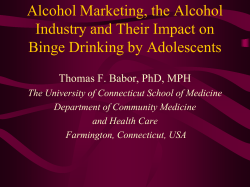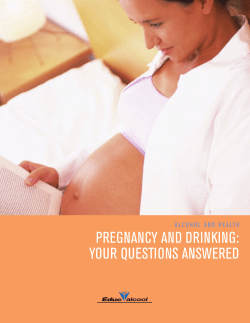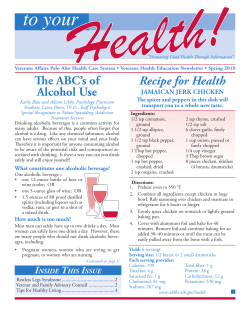
Preserving the quality of life. Innovative solutions for drinking water treatment.
→→ Drinking water treatment Innovative solutions for drinking water treatment. Preserving the quality of life. 02 Drinking water treatment Drinking water treatment Drinking water. A high-quality beverage. Clean water is one of the fundamental building blocks of a high quality of life. But utilities are facing increasing demands to provide it because the world’s water resources are under growing pressure, both in terms of quality and quantity. While quantity demands are due to the globally increasing need for fresh water, higher quality demands are mainly driven by the escalating pollution load on ground and surface waters and by increasingly strict legal regulations concerning drinking water quality. Filling and transport of liquid gas Linde delivers drinking water quality Drinking water is vital for life and serves as the major component for products of the food and beverage industry. It has to meet the highest quality requirements, which are regulated by law and strictly controlled. For many years, gases from Linde have been successfully contributing to the optimisation of the quality of water. Among the most commonly used applications are the removal of water contaminants with oxygen and the tuning of the pH value for the improvement of corrosion-chemical properties with carbon dioxide. One-stop complete solutions As one of the leading companies of the industrial gases industry, Linde commands a global network for the provision and distribution of the required gases. Our experts develop the complete engineering solutions for the storage, metering and addition of the gases. To efficiently introduce the gases, well-proven Linde processes are available: SOLVOX®: SOLVOCARB®: Process for dissolving of oxygen Process for dissolving of carbon dioxide SOLVOX® and SOLVOCARB® are registered trademarks of The Linde Group. Gas metering unit 03 04 Drinking water treatment Clear water through oxygen. Removal of water contaminants with SOLVOX®. Oxidative drinking water treatment Raw waters often contain high concentrations of dissolved iron and manganese, as well as ammonium ions and other reduced chemical species. Iron and manganese ions are undesirable, as they precipitate within the drinking water supply network, where they lead to corrosion. That is why, after the enrichment of raw water with oxygen, heavy metal ions are already removed, with the aid of microorganisms, in the filter systems of the waterworks. As the specific oxygen demand for this is low, it can usually be met with atmospheric oxygen. If further oxidisable substances such as ammonium or methane are contained in the water, a higher oxygen concentration is required which can be adjusted reliably and economically with Linde’s SOLVOX® process. Specific oxygen demand for the oxidation of: 1 g iron (II) 0.149 g 1 g manganese (II) 0.299 g 1 g ammonium 3.569 g 1 g methane 4.000 g High efficiency at low operating costs In comparison to air, pure oxygen has a 4.8 times higher theoretical oxygen saturation concentration in water. Thus the increase of the oxygen content is easily possible without high energy input. Compared to air, the gas volume that has to be fed into the raw water is dramatically decreased, reducing the amount of carbon dioxide that is lost through stripping to atmosphere. Since there is no disruption of the filter operation through nitrogen emission, the filter life is extended and there are less operating costs for backwashing. O2 saturation concentration cs of air and of oxygen in pure water at 1 bar Oxygen Air 80 70 60 c s (mg/l) In water, a multitude of natural purification processes take place that consume dissolved oxygen. Therefore, especially in ground water and in deep water from dams, the oxygen concentration can be very low to zero. 60.7 53.7 50 48 43.4 40 39.5 36 33.2 30 30.8 20 10 12.4 10.9 9.8 8.8 8.1 7.5 7 6.6 0 5 10 15 20 25 30 35 40 Temperature (°C) c s (O2) = 4.8 x c s (air) Oxygen assures drinking water quality Apart from the removal of water contaminants, oxygen is also needed for the build-up and maintenance of a corrosion-inhibiting protective layer in metallic drinking water pipes. A pure water oxygenation to 6 mg/l helps to assure perfect drinking water quality in the supply network and improves the taste of the water. Advantages of oxygen application: →→ Improvement of the pure water quality →→ Better taste of the water →→ Improvement of the filter system performance →→ Reduction of operating costs →→ Avoidance of carbon dioxide strip loss →→ Protection against corrosion Clearly clearer. Ozone reduces organic contaminations. The removal of organic water contaminants is carried out after a pretreatment of the raw water involving ozone. Resistant substances, for example humic material complexes, are broken down with ozone to a point where they are ready for further biological treatment. The influence of ozonisation is reflected in the noticeable improvement of the water’s organoleptic properties such as smell, taste, clearness and colour. Ozone is produced on site from dehumidified air or oxygen and quickly reacts with water contaminants. During the reaction of ozone, oxygen is formed, which means that there is no additional water contamination. Advantages of ozone production with oxygen: →→ Higher ozone yield with less energy consumption →→ Smaller system dimensions →→ No pre-drying required Further application areas for ozone: →→ Oxidation of anthropogenic substances such as drug residues and pesticides →→ De-ironing, de-manganisation →→ Disinfection and inactivation of viruses 06 Drinking water treatment Drinking water treatment Optimal conditions. SOLVOX® processes for targeted dissolving of oxygen. SOLVOX®-D The SOLVOX processes have been developed for the economical introduction of oxygen into water. They assure optimal oxygen utilisation under the given operating conditions. ® The SOLVOX®-D process is specially designed for the injection of oxygen into pressure pipe lines, where the oxygen is fed directly into the raw water stream through a stainless steel nozzle. The process efficiency can be further enhanced by the downstream installation of a static mixer. Depending on the case of application, the oxygen is fed directly into the raw water feed of the filter system or fed into the supply system separately before the introduction of the drinking water, using either nozzles (SOLVOX®-D) or reactors (SOLVOX®-R). For maintenance work, the nozzle can be easily dismantled and cleaned without having to interrupt the operation. Additional benefits of the SOLVOX®-D process: →→ No extra energy required →→ Low investment costs →→ Fast and easy installation →→ Low maintenance The metering of the oxygen is carried out in an automatic control unit, depending on the flow rate and the oxygen concentration of the raw water. SOLVOX®-D process, inline operation SOLVOX®-R process, inline operation Pure water storage Raw water well Filter Raw water well SOLVOX®-D injection device SOLVOX®-R reactor Pure water storage SOLVOX®-R Filter Q H 2O SOLVOX -D nozzle ® Consumer Consumer Q H 2O O2 O2 Measurement and control unit Measurement and control unit Liquid oxygen Liquid oxygen In the SOLVOX®-R process, the oxygen is dissolved in a stainless steel pressure vessel. The oxygenation can be carried out in an inline or bypass operation. Essential benefits of the SOLVOX®-R process: →→ Maximum oxygen utilisation →→ High oxygen concentration achievable →→ Low pressure loss in the input system →→ Low maintenance SOLVOX®-R reactor 07 08 Drinking water treatment Drinking water treatment 09 Effective against corrosion. SOLVOCARB® and carbon dioxide. Optimal hardness increase through carbon dioxide Distribution of CO2 species in water as a function of the pH value at 10 °C CO2 HCO3- CO32- Lime-carbonic acid equilibrium, summary presentation: 100 80 Percentage of CO2 species (%) In terms of distribution, drinking water is ideally within the range of its calcite saturation. But if more carbon dioxide is dissolved in the water than equals the equilibrium amount, the excess carbon dioxide attacks the existing protective layer in the piping network and causes corrosion damages on concrete and metal pipes. If, on the other hand, a water contains too little dissolved carbon dioxide, the pH value of its calcite saturation is exceeded and lime precipitation in pipelines and taps is the result. CaCO3 + CO2 + H2O Ca2+ + 2 HCO3- 80 →→ CO2 addition: Calcite dissolution (hardness increase) →→ CO2 removal: Calcite precipitation (de-carbonisation) 70 60 50 40 30 20 10 0 4 5 6 7 8 9 pH value 10 11 12 Buffering capacity and corrosiveness of a water are based upon the reaction of CO2 species with the calcium ion, which precipitates from the water in the form of sparingly soluble calcium carbonate (calcite, CaCO3). If the acid content and the concentration of calcium ions of a water is in equilibrium (lime-carbonic acid equilibrium), calcite is neither dissolved nor precipitated. The state of calcite saturation is char acterised by the equilibrium pH value. 13 SOLVOCARB®. Brings water back in balance. During drinking water treatment, a water can acquire a calcite-precipitating property, e.g. by open aeration or after a rapid de-carbonisation with lime milk. As a result, downstream plant components such as pipes and valves show heavy scaling and the service life of filters is significantly shortened. In such cases, the addition of carbon dioxide with a simultaneous lower ing of the pH value prevents or reverses the precipitation of calcite. The lime-carbonic acid equilibrium can also be precisely readjusted in lime precipitation of raw waters by regulating the pH value with carbon dioxide. The content of dissolved calcium and magnesium ions defines the hardness of a water. Hardness agents are necessary for the build-up of a lime-rust protection layer within the drinking water network, but for this, they have to exist in sufficient concentration in the water. Smooth pH value adjustment with carbon dioxide. Efficient and safe. The addition of carbon dioxide into water creates carbonic acid: Raw waters from lime-poor regions as well as dam waters contain only small amounts of hardness ions, and without treatment, these have a corrosive effect and cannot form a protective layer. After desalination, drinking water from sea water also produces waters with low buffer capacities which have to be hardened before distribution. Through the addition of carbon dioxide and an equivalent amount of lime milk, the ideal water hardness can be precisely adjusted to a given pH target value. The application of carbon dioxide or carbonic acid is the ideal alternative to mineral acid metering for adjusting the pH value of poorly buffered waters such as drinking water. A fundamental advantage of carbonic acid is based on the flat course of its neutralisation curve, es pecially within the admissible pH range of drinking water. Due to this advantage, the desired pH value can be adjusted easily and precisely even at variable raw water parameters, without the danger of acidification. With the SOLVOCARB® processes, Linde not only offers the gases supply, but also the know-how and the required hardware for the efficient in jection of carbon dioxide into water. Further advantages compared to mineral acid: →→ No salinity increase →→ No adverse effect on the taste →→ No corrosion damages on plant components →→ Easy metering →→ Safe handling →→ Safe and easy storage →→ Excellent value for money Advantages of carbon dioxide application: →→ Exact adjustment of the ideal water hardness →→ Higher buffer capacity →→ Better taste of the water →→ Prevention of scaling →→ Minimisation of corrosion CO2 + H2O Neutralisation of sodium hydroxide solution with CO2 and with mineral acid 14 Percentage of CO2 species (%) Carbon dioxide is a component of natural waters, where it exists predominantly as a physically dissolved gas. A small part of it reacts with water to form carbonic acid (H2CO3) which, depending on the temperature and pH value, splits up into its anions hydrocarbonate (HCO3-) and carbonate (CO32-) 12 10 Admissible range CO2 Mineral acid 8 6 4 Phase I Phase II 2 2 OH- + CO2 CO32- + CO2 + H2O 0 CO32- + H2O Phase III 2 HCO3Absorbed amount of CO2 or mineral acid H2CO3 HCO3- + H+ CO32- + 2 H+ 10 Drinking water treatment Drinking water treatment Economical solutions for individual requirements. Precise addition of carbon dioxide with SOLVOCARB®. With the SOLVOCARB® process, Linde provides tried and tested, rea sonably priced metering and dissolving systems for carbon dioxide. The nozzles and reactors of the SOLVOCARB® family can be applied flexibly in an inline or bypass operation, thus offering a broad range of solutions for specific customer requirements. SOLVOCARB®-D process, inline operation Waterworks Drinking water treatment Raw water well Waterworks Drinking water treatment Q H 2O pH Measurement and control unit Consumer Liquid carbon dioxide Pure water storage SOLVOCARB® -R reactor Raw water well SOLVOCARB®-D nozzle Q H 2O pH Measurement and control unit SOLVOCARB®-R reactor with CO2 metering unit SOLVOCARB®-D SOLVOCARB®-R The SOLVOCARB®-D process has been specially developed for the injec tion of carbon dioxide into pressure pipe lines, where the carbon dioxide is fed directly into a raw water stream through a stainless steel nozzle. Downstream of the injection point, a reaction section is required where the carbon dioxide dissolves. The reaction section can be significantly shortened by the installation of a static mixer. In the SOLVOCARB®-R process, the carbon dioxide is dissolved in a reactor. Reactors of various designs and material configurations are available for different types of application conditions. Advantages of the SOLVOCARB®-D process: →→ No extra energy required →→ Low investment costs →→ Fast and easy installation →→ Maintenance without service interruption →→ Low maintenance SOLVOCARB®-R process, bypass operation Pure water storage SOLVOCARB®-D injection device Consumer Liquid carbon dioxide Essential advantages of the SOLVOCARB®-R process: →→ High gas utilisation →→ Low maintenance 11 Getting ahead through innovation. With its innovative concepts, Linde is playing a pioneering role in the global market. As a technology leader, it is our task to constantly raise the bar. Traditionally driven by entrepreneurship, we are working steadily on new high-quality products and innovative processes. Linde offers more. We create added value, clearly discernible competitive advantages, and greater profitability. Each concept is tailored specifically to meet our customers’ requirements – offering standardised as well as customised solutions. This applies to all industries and all companies regardless of their size. If you want to keep pace with tomorrow’s competition, you need a partner by your side for whom top quality, process optimisation, and enhanced productivity are part of daily business. However, we define partnership not merely as being there for you but being with you. After all, joint activities form the core of commercial success. Linde – ideas become solutions. Für Sie einheitlich erreichbar – bundesweit in Ihrer Nähe. Vertriebszentren/Kundenservice allgemein Berlin Hannover München Düsseldorf Leuna Nürnberg Hamburg Mainz Stuttgart Telefon 01803.85000-0* Telefax 01803.85000-1*n Lorem ipsum 12345678 Linde AG Linde Gases Division, Seitnerstrasse 70, 82049 Pullach, Germany Phone +49.89.7446-0, Fax +49.89.7446-1230, www.linde-gas.com 1209 – 1.X L&P *0,09 € pro Minute aus dem Festnetz. Abweichende Preise aus dem Mobilfunknetz. Zur Sicherstellung eines hohen Niveaus der Kundenbetreuung werden Daten unserer Kunden wie z. B. Telefonnummern elektronisch gespeichert und verarbeitet
© Copyright 2025












